Effect of Pore Fluid Pressure on the Normal Deformation of a Matched Granite Joint
Abstract
:1. Introduction
2. Experimental Apparatus and Principle
2.1. Material
2.2. Test Apparatus and Principle
2.3. Test Procedure
3. Test Results and Analysis
3.1. Hydrostatic Compression Test
3.2. N2 Injection Test of Jointed Sample
3.3. Water Injection Test of Jointed Sample
4. Discussion
4.1. Impacts of Pore Fluid Pressure on Jointed Sample
4.2. Quantification the Normal Deformation of the Joint Under Pore Pressure Condition
4.3. Quantification of Host Rock Deformation under Pore Pressure Condition
5. Conclusions
Author Contributions
Funding
Conflicts of Interest
References
- Xia, C.C.; Yue, Z.Q.; Tham, L.G.; Lee, C.F.; Sun, Z.Q. Quantifying topography and closure deformation of rock joints. Int. J. Rock Mech. Min. Sci. 2003, 40, 197–220. [Google Scholar] [CrossRef]
- Malama, B.; Kulatilake, P.H.S.W. Models for normal fracture deformation under compressive loading. Int. J. Rock Mech. Min. Sci. 2003, 40, 893–901. [Google Scholar] [CrossRef]
- Pyrack-Nolte, L. Hydraulic and Mechanical Properties of Natural Fractures in low-Permeability Rock; International Society for Rock Mechanics and Rock Engineering: Montreal, QC, Canada, 1987. [Google Scholar]
- Desai, C.S.; Rigby, D.B. Cyclic Interface and Joint Shear Device Including Pore Pressure Effects. J. Geotech. Geoenviron. Eng. 1997, 123, 568–579. [Google Scholar] [CrossRef]
- Jaeger, J.C.; Cook, N.G.W.; Zimmerman, R. Fundamentals of Rock Mechanics, 4th ed.; John Wiley & Sons: Hoboken, NJ, USA, 2007. [Google Scholar]
- Cappa, F.; Guglielmi, Y.; Rutqvist, J.; Tsang, C.-F.; Thoraval, A. Hydromechanical modelling of pulse tests that measure fluid pressure and fracture normal displacement at the Coaraze Laboratory site, France. Int. J. Rock Mech. Min. Sci. 2006, 43, 1062–1082. [Google Scholar] [CrossRef] [Green Version]
- Rutqvist, J.; Stephansson, O. The role of hydromechanical coupling in fractured rock engineering. Hydrogeol. J. 2003, 11, 7–40. [Google Scholar] [CrossRef] [Green Version]
- Bart, M.; Shao, J.F.; Lydzba, D.; Haji-Soutoudeh, M. Coupled hydromechanical modeling of rock fractures under normal stress. Can. Geotech. J. 2004, 41, 686–697. [Google Scholar] [CrossRef]
- Yang, H.; Xie, S.Y.; Secq, J.; Shao, J.F. Experimental study and modeling of hydromechanical behavior of concrete fracture. Water Sci. Eng. 2017, 10, 97–106. [Google Scholar] [CrossRef]
- Ji, S.H.; Koh, Y.K.; Kuhlman, K.L.; Lee, M.Y.; Choi, J.W. Influence of pressure change during hydraulic tests on fracture aperture. Groundwater 2013, 51, 298–304. [Google Scholar] [CrossRef] [PubMed]
- Kamali-Asl, A.; Ghazanfari, E.; Perdrial, N.; Bredice, N. Experimental study of fracture response in granite specimens subjected to hydrothermal conditions relevant for enhanced geothermal systems. Geothermics 2018, 72, 205–224. [Google Scholar] [CrossRef]
- Vogler, D.; Amann, F.; Elsworth, D. Permeability Evolution in Natural Fractures Subject to Cyclic Loading and Gouge Formation. Rock Mech. Rock Eng. 2016, 49, 3463–3479. [Google Scholar] [CrossRef]
- Barton, N.; Bandis, S.; Bakhtar, K. Strength, deformation and conductivity coupling of rock joints. Int. J. Rock Mech. Min. Sci. Geomech. Abstr. 1985, 22, 121–140. [Google Scholar] [CrossRef]
- Swan, G. Determination of stiffness and other joint properties from roughness measurements. Rock Mech. Rock Eng. 1983, 16, 19–38. [Google Scholar] [CrossRef]
- Sun, Z. Study on the deformation vs stress properties of discontinuous. Chin. J. Rock Mech. Eng. 1987, 4, 287–300. [Google Scholar]
- Sun, G.; Lin, W. The principle of closed deformation of structural plane and elastic deformation constitutive equation of rock mass. Chin. J. Rock Mech. Eng. 1982, 2, 177–180. [Google Scholar]
- Goodman, R.E. Methods of Geological Engineering in Discontinuous Rocks; West Publishing Company: Eagan, MN, USA, 1976. [Google Scholar]
- Rong, G.; Huang, K.; Zhou, C.B.; Wang, X.J.; Peng, J. A new constitutive law for the nonlinear normal deformation of rock joints under normal load. Sci. Chin. Technol. Sci. 2011, 55, 555–567. [Google Scholar] [CrossRef]
- Sharp, J.C.; Maini, Y. Fundamental considerations on the hydraulic characteristics of joints in rock. In Proceedings of the Symposium of Percolation through Fissured Rock, Stuttgart, Germany, 18–19 September 1972. [Google Scholar]
- Sun, Z.; Gerrard, C.; Stephansson, O. Rock joint compliance tests for compression and shear loads. Int. J. Rock Mech. Min. Sci. Geomech. Abstr. 1985, 22, 197–213. [Google Scholar] [CrossRef]
- Yu, J.; Zhao, X.; Zhao, W.; Li, X.; Guan, Y. Improved nonlinear elastic constitutive model for normal deformation of rock fractures. Chin. J. Geotech. Eng. 2008, 30, 1316–1321. [Google Scholar]
- Desai, C.S.; Ma, Y. Modelling of joints and interfaces using the disturbed-state concept. Int. J. Numer. Anal. Method. Geomech. 1992, 16, 623–653. [Google Scholar] [CrossRef]
- Snow, D.T. Anisotropie Permeability of Fractured Media. Water Resour. Res. 1969, 5, 1273–1289. [Google Scholar] [CrossRef]
- Witherspoon, P.A.; Wang, J.S.Y.; Iwai, K.; Gale, J.E. Validity of Cubic Law for fluid flow in a deformable rock fracture. Water Resour. Res. 1980, 16, 1016–1024. [Google Scholar] [CrossRef] [Green Version]
- Amadei, B.; Illangasekare, T. A mathematical model for flow and solute transport in non-homogeneous rock fractures. Int. J. Rock Mech. Min. Sci. Geomech. Abstr. 1994, 31, 719–731. [Google Scholar] [CrossRef]
- Cornet, F.H.; Li, L.; Hulin, J.-P.; Ippolito, I.; Kurowski, P. The hydromechanical behaviour of a fracture: An in situ experimental case study. Int. J. Rock Mech. Min. Sci. 2003, 40, 1257–1270. [Google Scholar] [CrossRef]
- Duan, X.; Li, J.; Liu, J. Numerical simulation of flow motion of fractured rock mass under the interaction of stress field and seepage field. J. Dalian Univ. Technol. 1992, 32, 712–717. [Google Scholar]
- Chen, P.; Zhang, Y. Seepage and stress coupling analysis of fractured rock mass. Chi. J. Rock Mech. Eng. 1994, 13, 299–308. [Google Scholar]
- Runslätt, E.; Thörn, J. Fracture Deformation When Grouting in Hard Rock: In Situ Measurements in Tunnels under Gothenburg and Hallandsås. Available online: http://publications.lib.chalmers.se/records/fulltext/126954.pdf (accessed on 30 June 2018).
- Schweisinger, T.; Svenson, E.J.; Murdoch, L.C. Hydromechanical behavior during constant-rate pumping tests in fractured gneiss. Hydrol. J. 2011, 19, 963–980. [Google Scholar] [CrossRef]
- Nur, A.; Byerlee, J.D. An exact effective stress law for elastic deformation of rock with fluids. J. Geophys. Res. 1971, 76, 6414–6419. [Google Scholar] [CrossRef]
- Brace, W.F.; Martin, R.J. A test of the law of effective stress for crystalline rocks of low porosity. Int. J. Rock Mech. Min. Sci. Geomech. Abstr. 1968, 5, 415–426. [Google Scholar] [CrossRef]
- Berryman, J.G. Effective stress for transport properties of inhomogeneous porous rock. J. Geophys. Res. 1992, 97, 17409–17424. [Google Scholar] [CrossRef]
- Shi, L.; Li, X.; Bing, B.; Wang, A.; Zeng, Z.; He, H. A Mogi-Type True Triaxial Testing Apparatus for Rocks with Two Moveable Frames in Horizontal Layout for Providing Orthogonal Loads. Geotech. Test. J. 2017, 40, 542–558. [Google Scholar] [CrossRef]
- Hu, S.; Li, X.; Bai, B.; Shi, L.; Liu, M.; Wu, H. A modified true triaxial apparatus for measuring mechanical properties of sandstone coupled with CO2-H2O biphase fluid. Greenh. Gas. Sci. Technol. 2017, 7, 78–91. [Google Scholar] [CrossRef]
- Cook, N.G. Natural joints in rock: Mechanical, hydraulic and seismic behaviour and properties under normal stress. Int. J. Rock Mech. Min. Sci. Geomech. Abstr. 1992, 29, 198–223. [Google Scholar] [CrossRef]
- Zoback, M.D.; Byerlee, J.D. The effect of microcrack dilatancy on the permeability of westerly granite. J. Geophys. Res. 1975, 80, 752–755. [Google Scholar] [CrossRef] [Green Version]
- Walsh, J.B. Effect of pore pressure and confining pressure on fracture permeability. Int. J. Rock Mech. Min. Sci. Geomech. Abstr. 1981, 18, 429–435. [Google Scholar] [CrossRef]
- Cheng, C.; Li, X.; Li, S.; Zheng, B. Failure Behavior of Granite Affected by Confinement and Water Pressure and Its Influence on the Seepage Behavior by Laboratory Experiments. Materials 2017, 10, 798. [Google Scholar] [CrossRef] [PubMed]
- Rice, J.R.; Cleary, M.P. Some basic stress diffusion solutions for fluid-saturated elastic porous media with compressible constituents. Rev. Geophys. 1976, 14, 227–241. [Google Scholar] [CrossRef]
- Zhou, X.; Burbey, T.J. Fluid effect on hydraulic fracture propagation behavior: a comparison between water and supercritical CO2-like fluid. Geofluids 2014, 14, 174–188. [Google Scholar] [CrossRef]
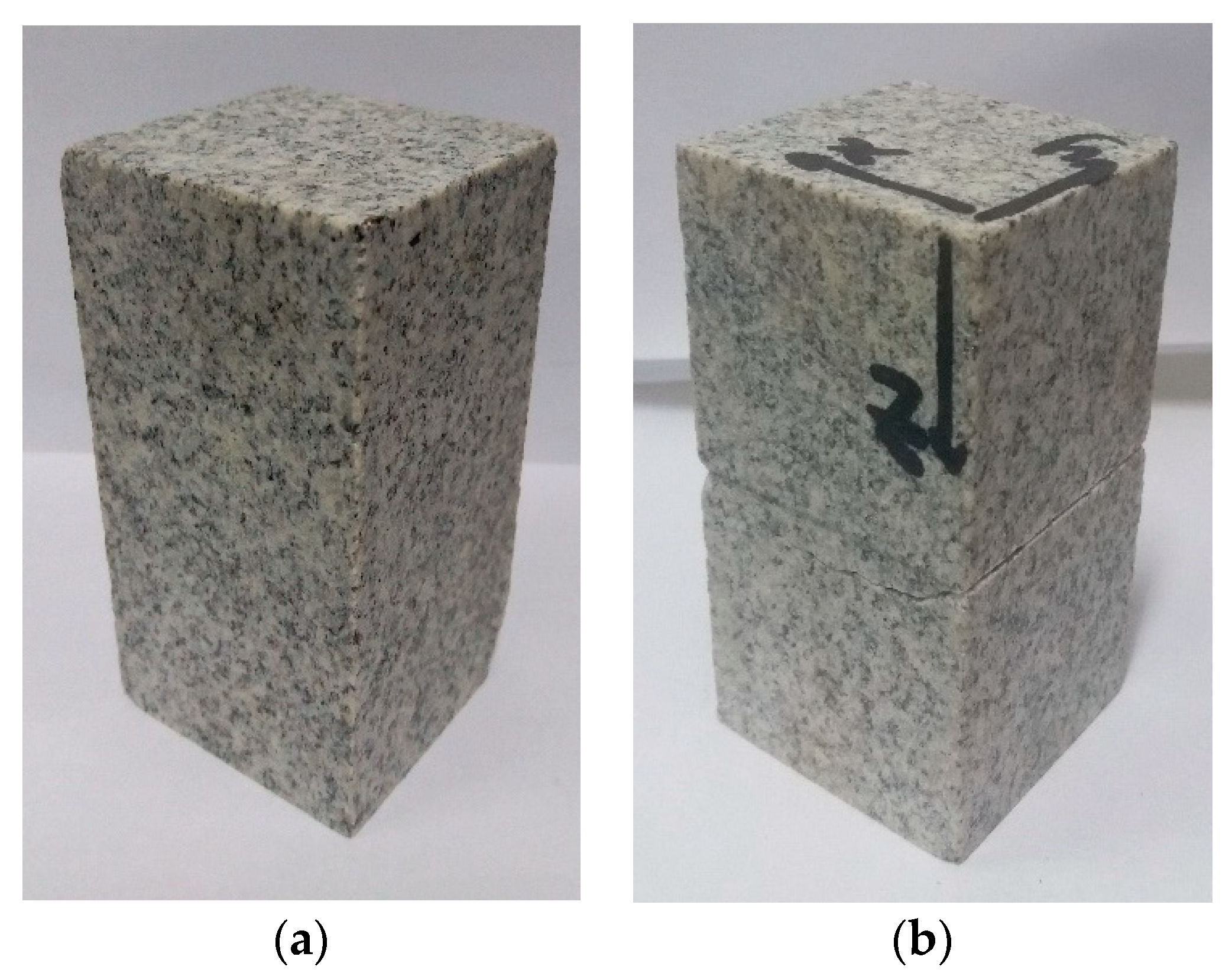
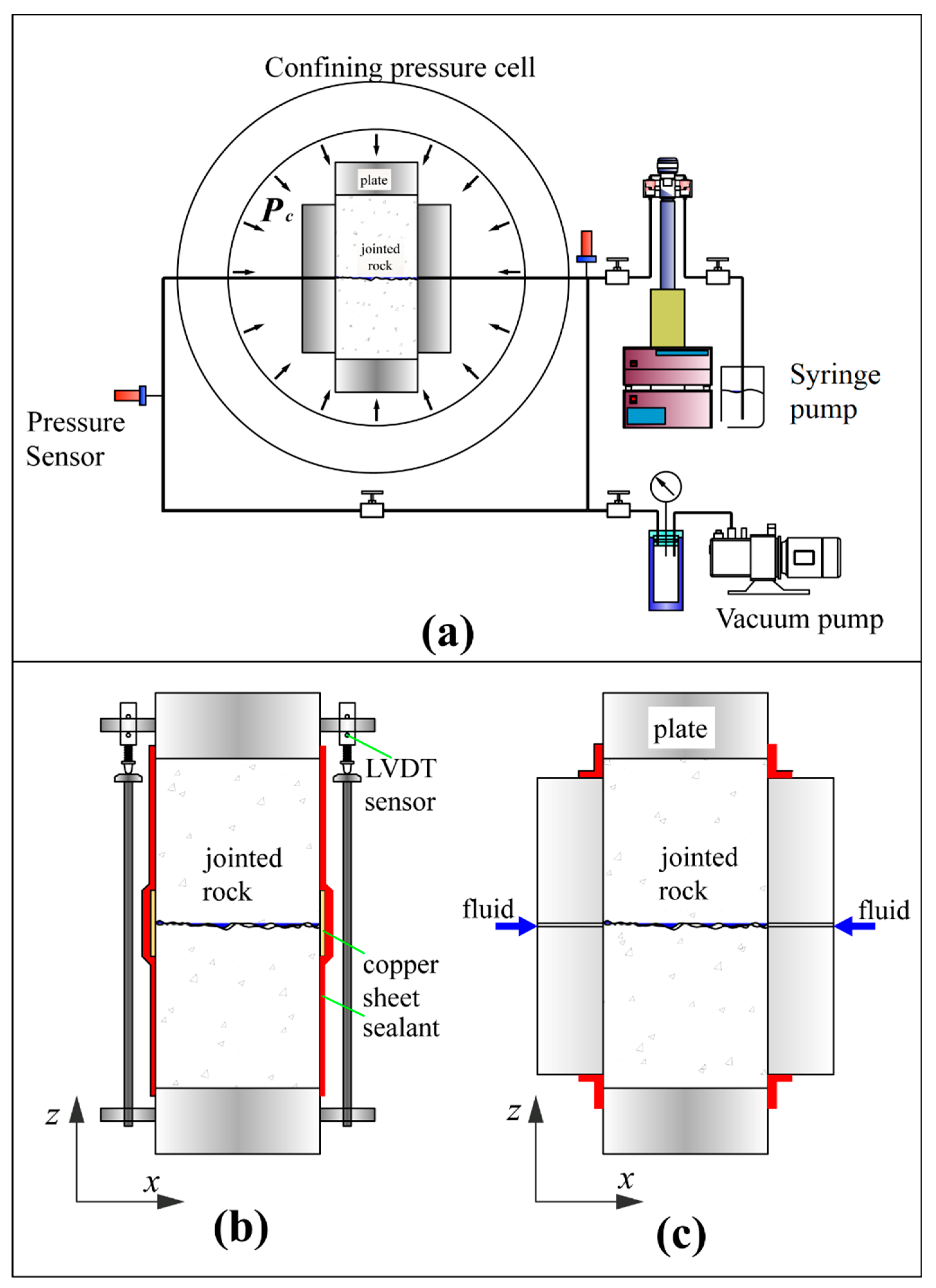
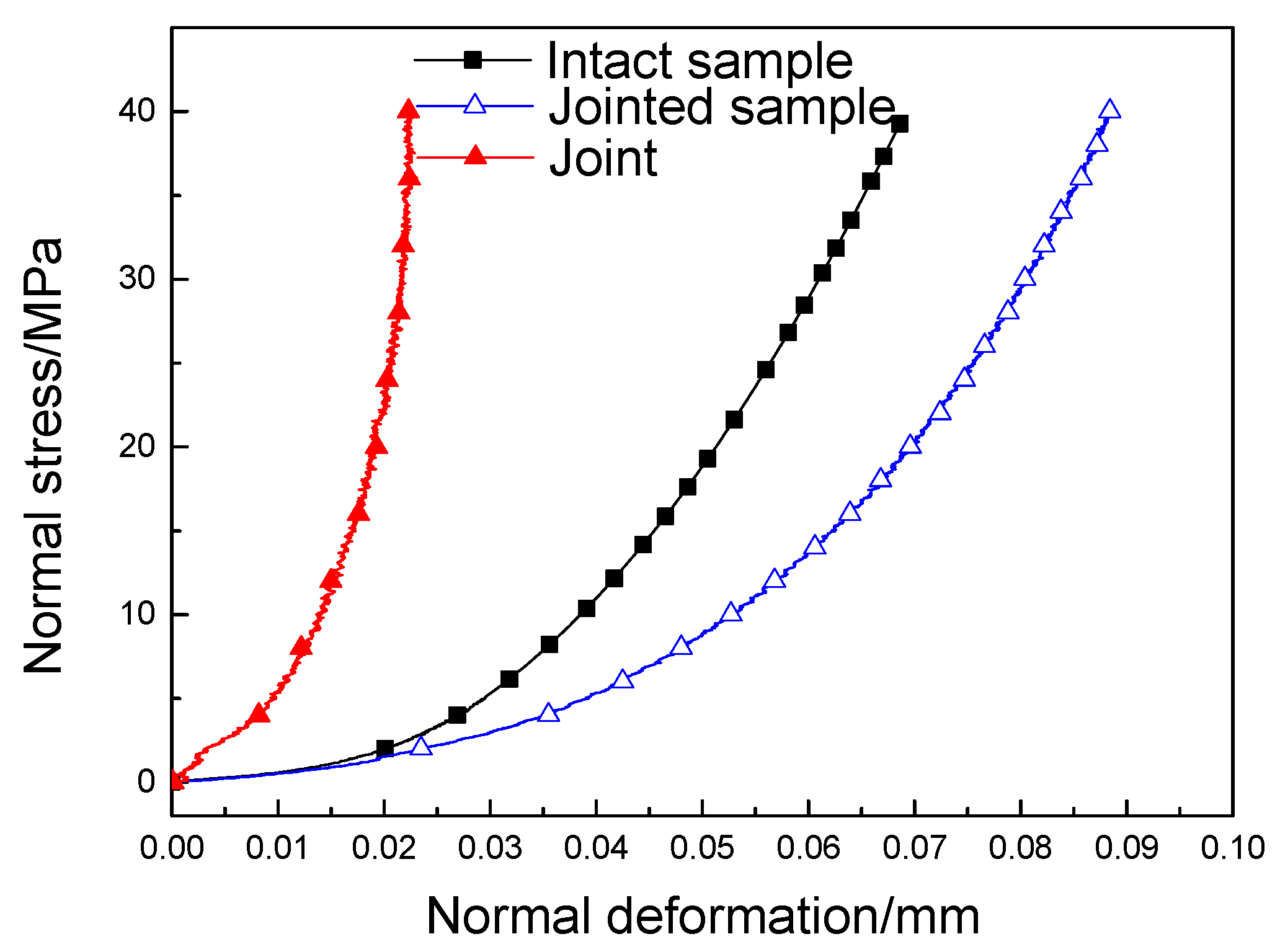
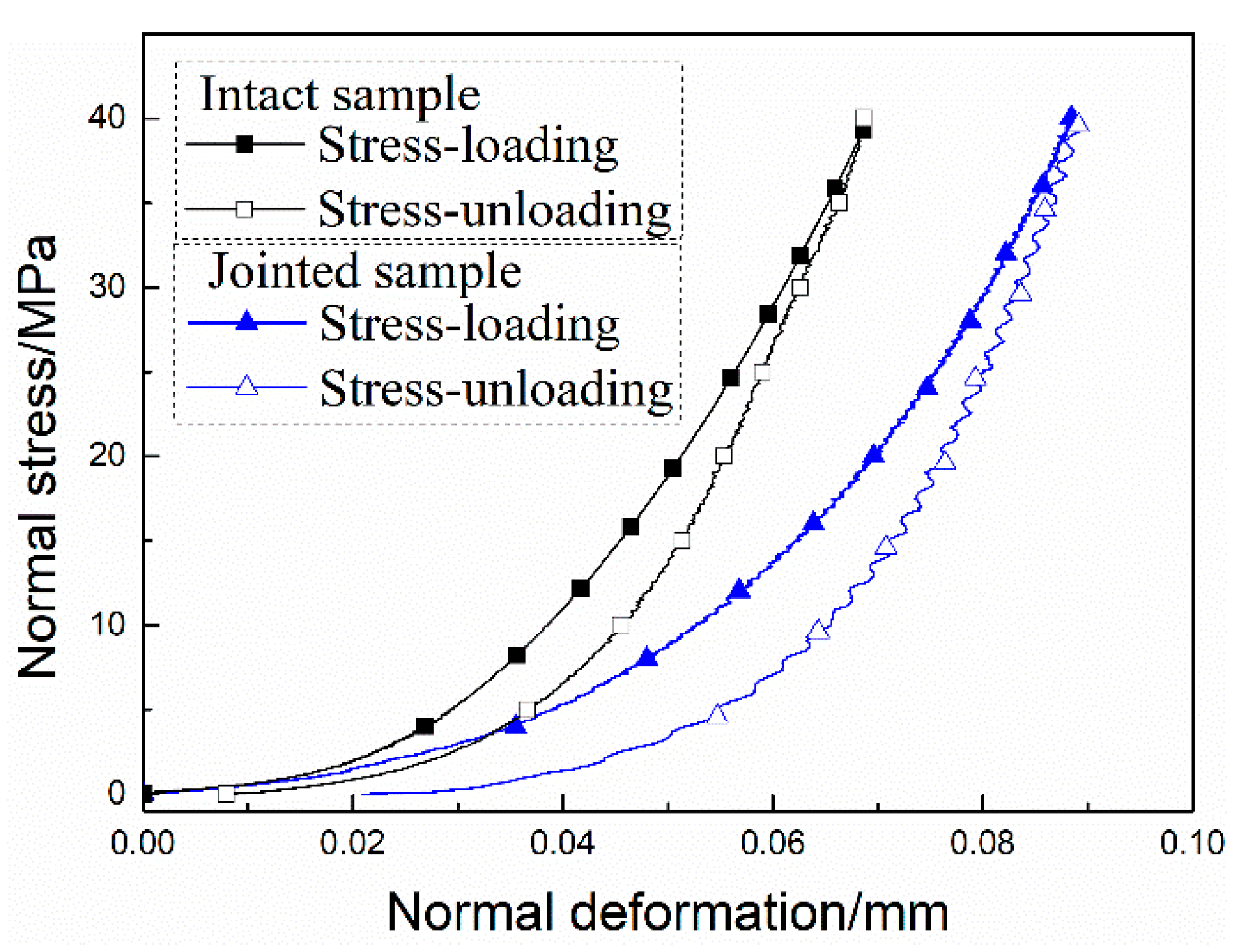

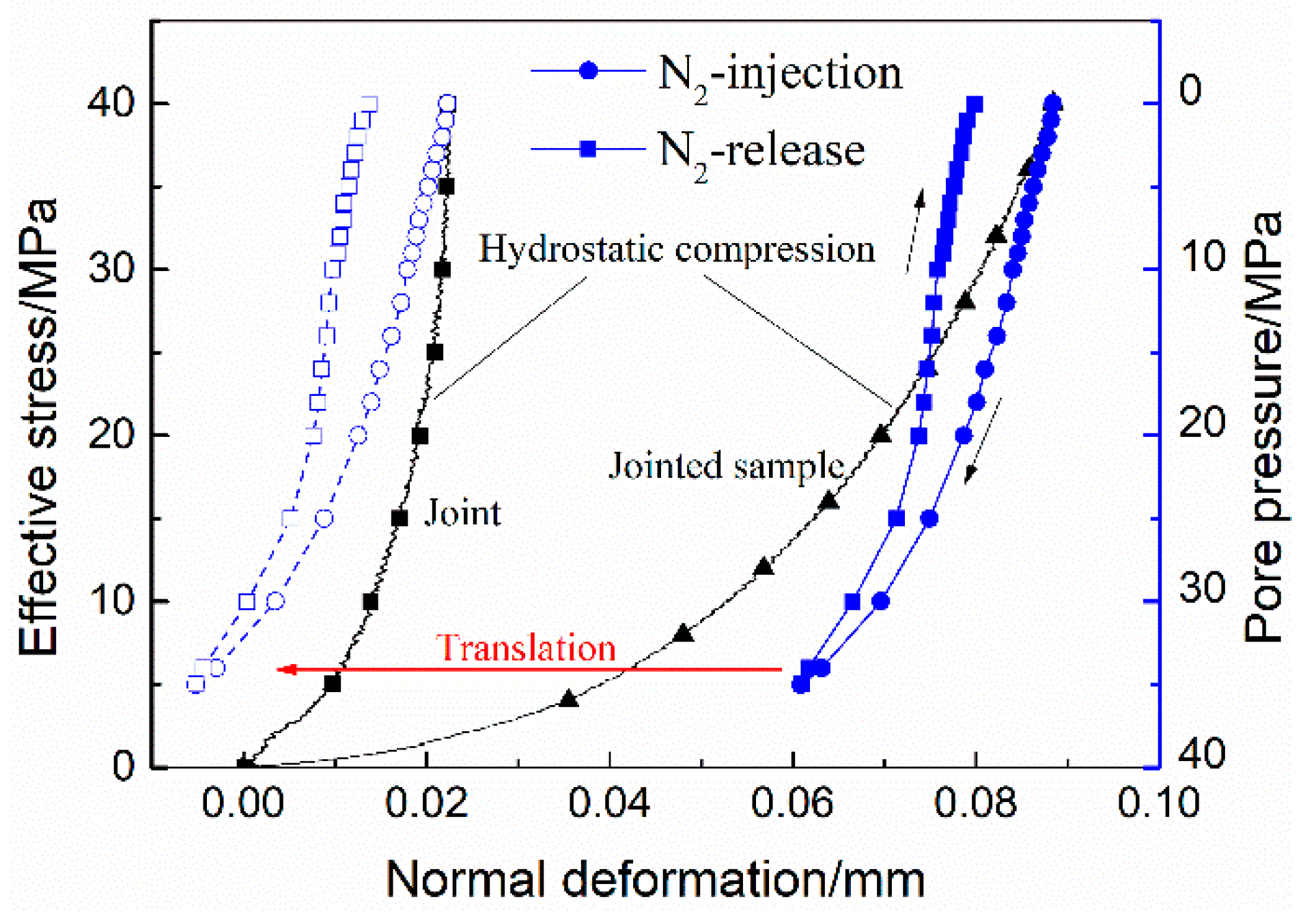
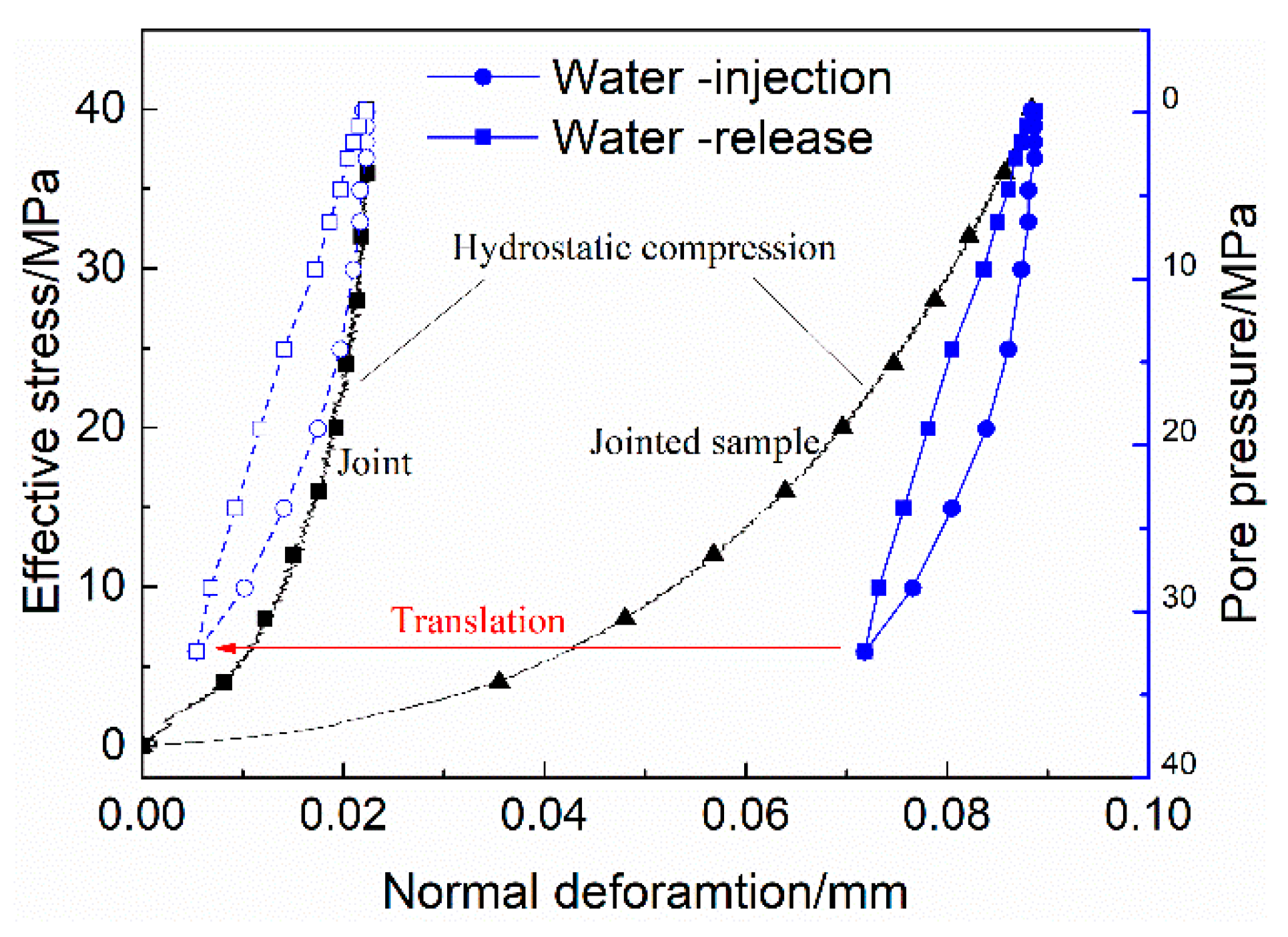
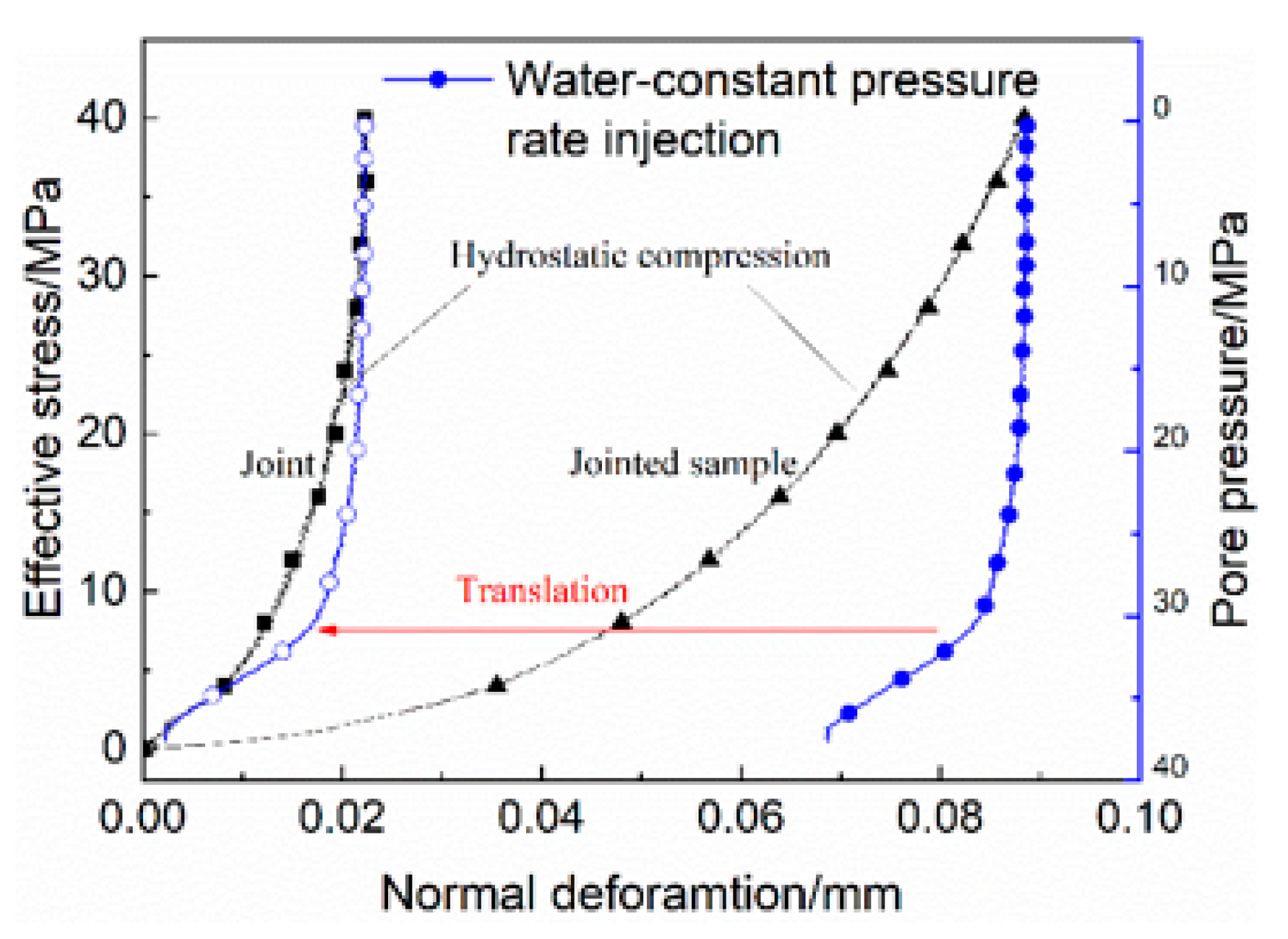
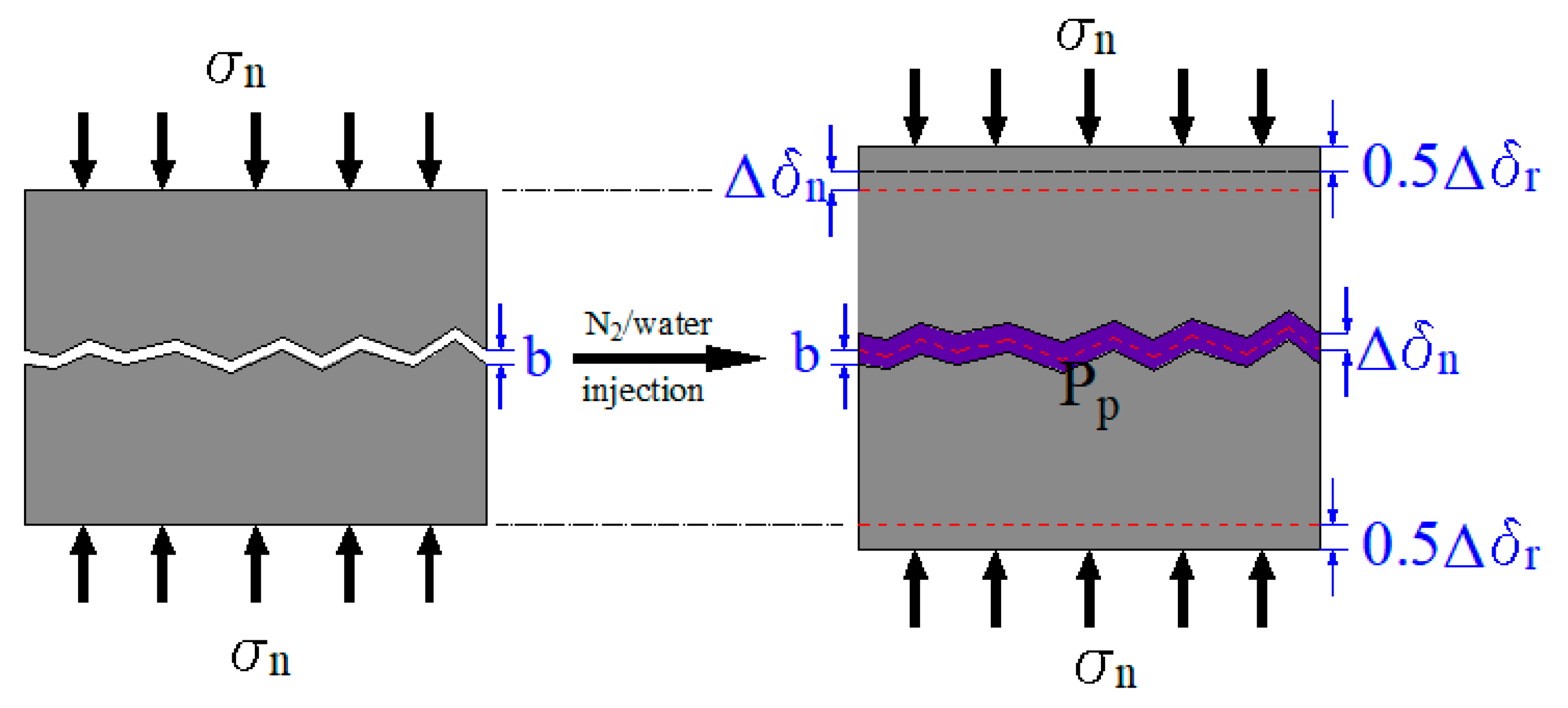
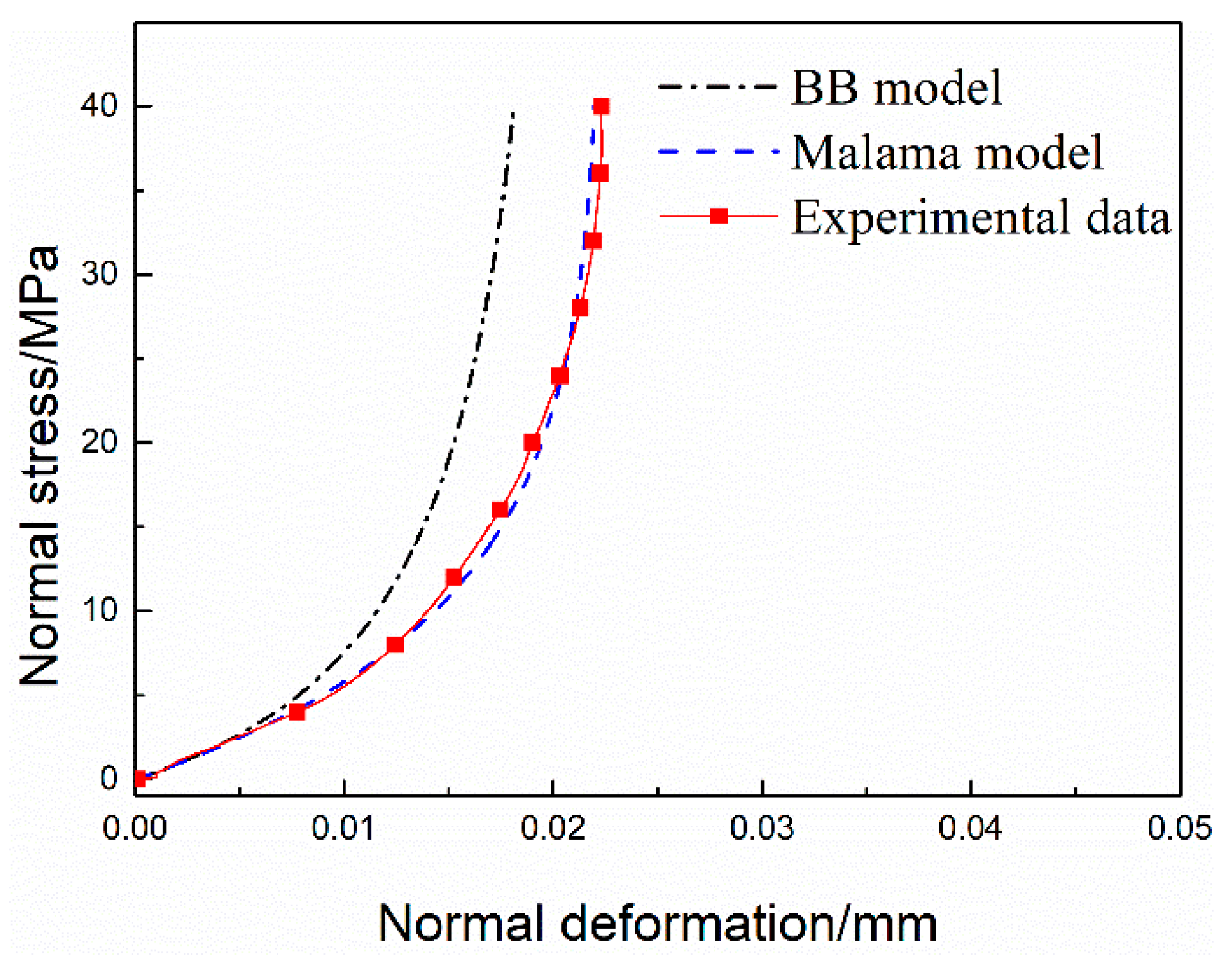
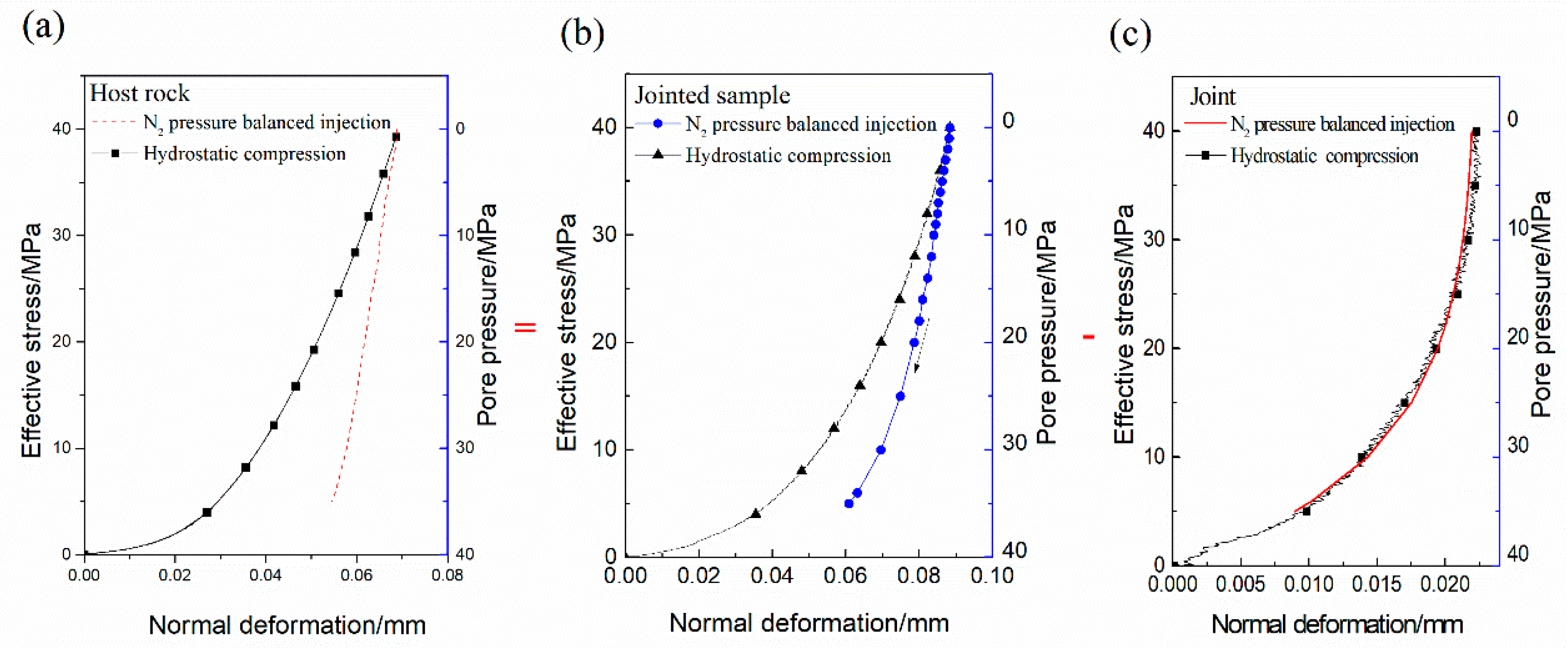
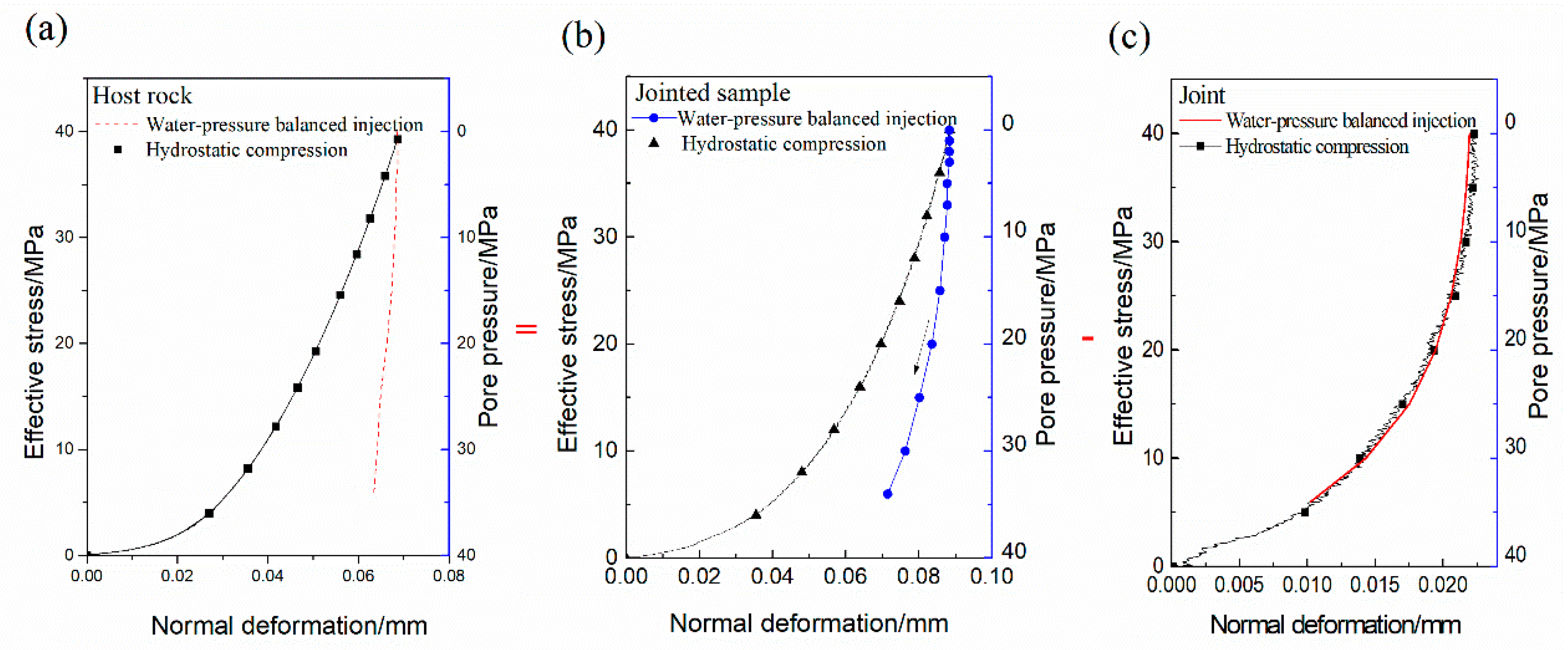
| Minerals | Quarts | Albite | Microcline | Muscovite | Orthoclase |
|---|---|---|---|---|---|
| wt % | 27.51 | 30.83 | 20.60 | 13.69 | 7.37 |
| Size/mm | Uniaxial Strength/MPa | Tensile Strength/MPa | Elasticity Modulus/GPa | Poisson‘s Ratio | Lame Elastic Constant | Shear Modulus |
|---|---|---|---|---|---|---|
| 50 × 50 × 100 | 172.5 | 4.59 | 57.29 | 0.226 | 23.36 | 19.27 |
| Maximum Normal Stress σmax/MPa | Half-Closure Stress σ1/2/MPa | Maximum Closure δmax/mm | Initial Normal Stiffness Kni/MPa·mm−1 | Parameter n |
|---|---|---|---|---|
| 40 | 6.76 | 0.0223 | 516.31 | 1 |
© 2018 by the authors. Licensee MDPI, Basel, Switzerland. This article is an open access article distributed under the terms and conditions of the Creative Commons Attribution (CC BY) license (http://creativecommons.org/licenses/by/4.0/).
Share and Cite
Zhang, Q.; Li, X.; Bai, B.; Hu, S.; Shi, L. Effect of Pore Fluid Pressure on the Normal Deformation of a Matched Granite Joint. Processes 2018, 6, 107. https://doi.org/10.3390/pr6080107
Zhang Q, Li X, Bai B, Hu S, Shi L. Effect of Pore Fluid Pressure on the Normal Deformation of a Matched Granite Joint. Processes. 2018; 6(8):107. https://doi.org/10.3390/pr6080107
Chicago/Turabian StyleZhang, Qiang, Xiaochun Li, Bing Bai, Shaobin Hu, and Lu Shi. 2018. "Effect of Pore Fluid Pressure on the Normal Deformation of a Matched Granite Joint" Processes 6, no. 8: 107. https://doi.org/10.3390/pr6080107





